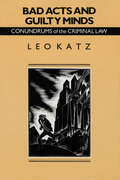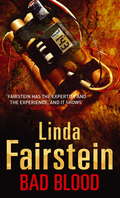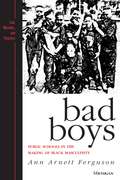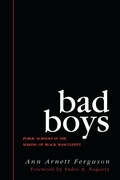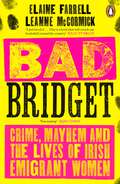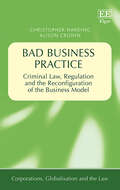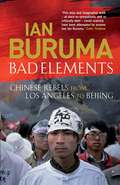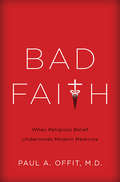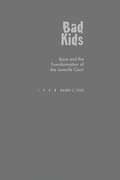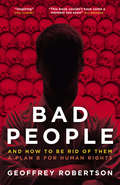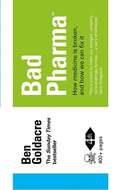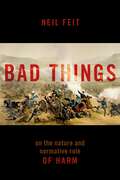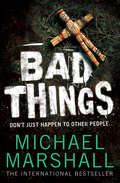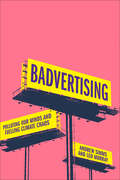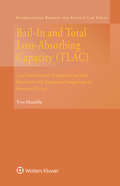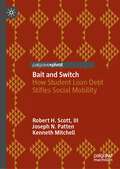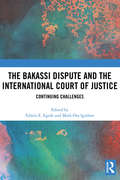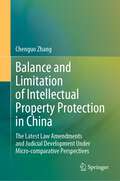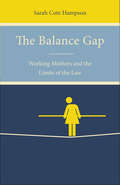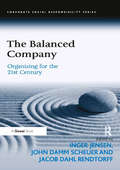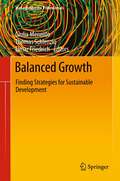- Table View
- List View
Bad Acts and Guilty Minds: Conundrums of the Criminal Law (Studies in Crime and Justice)
by Leo KatzWith wit and intelligence, Leo Katz seeks to understand the basic rules and concepts underlying the moral, linguistic, and psychological puzzles that plague the criminal law. "Bad Acts and Guilty Minds . . . revives the mind, it challenges superficial analyses, it reminds us that underlying the vast body of statutory and case law, there is a rationale founded in basic notions of fairness and reason. . . . It will help lawyers to better serve their clients and the society that permits attorneys to hang out their shingles."—Edward N. Costikyan, New York Times Book Review
Bad Blood: A Novel (Alexandra Cooper #9)
by Linda FairsteinAlexandra Cooper has a tough case to prosecute. Brendan Quillan, a wealthy businessman from the Upper East Side, has been charged with hiring an assassin to kill his wife, but the evidence is flimsy and the defendant has one of the most successful defence lawyers on his side. Then an explosion kills Quillan's brother, one of the construction workers in a tunnel being built to secure Manhattan's water supply. The blast isn't a terrorist act, nor is it an accident, but it looks as though Duke Quillan was the target. And none of the team investigating the murder had come across any hint that Brendan had a brother, never mind one so far on the other side of the tracks. With another case to solve, Alex, together with Detectives Chapman and Mercer, discover that Quillan's upbringing is very different from what they'd first assumed, and in the cupboard of his estranged family there are many skeletons, not all of them metaphorical. In a cliff-hanging whodunnit, Linda Fairstein takes the reader on a roller-coaster ride through New York and deep beneath its streets, to a conclusion which is as surprising as it is frightening.
Bad Boys: Public Schools in the Making of Black Masculinity (Law, Meaning, And Violence)
by Ann Arnett FergusonStatistics show that black males are disproportionately getting in trouble and being suspended from the nation's school systems. Based on three years of participant observation research at an elementary school, Bad Boys offers a richly textured account of daily interactions between teachers and students to understand this serious problem. Ann Arnett Ferguson demonstrates how a group of eleven- and twelve-year-old males are identified by school personnel as "bound for jail" and how the youth construct a sense of self under such adverse circumstances. The author focuses on the perspective and voices of pre-adolescent African American boys. How does it feel to be labeled "unsalvageable" by your teacher? How does one endure school when the educators predict one's future as "a jail cell with your name on it?" Through interviews and participation with these youth in classrooms, playgrounds, movie theaters, and video arcades, the author explores what "getting into trouble" means for the boys themselves. She argues that rather than simply internalizing these labels, the boys look critically at schooling as they dispute and evaluate the meaning and motivation behind the labels that have been attached to them. Supplementing the perspectives of the boys with interviews with teachers, principals, truant officers, and relatives of the students, the author constructs a disturbing picture of how educators' beliefs in a "natural difference" of black children and the "criminal inclination" of black males shapes decisions that disproportionately single out black males as being "at risk" for failure and punishment. Bad Boys is a powerful challenge to prevailing views on the problem of black males in our schools today. It will be of interest to educators, parents, and youth, and to all professionals and students in the fields of African-American studies, childhood studies, gender studies, juvenile studies, social work, and sociology, as well as anyone who is concerned about the way our schools are shaping the next generation of African American boys. Anne Arnett Ferguson is Assistant Professor of Afro-American Studies and Women's Studies, Smith College.
Bad Boys: Public Schools in the Making of Black Masculinity (Law, Meaning, And Violence)
by Ann Arnett FergusonBlack males are disproportionately "in trouble" and suspended from the nation’s school systems. This is as true now as it was when Ann Arnett Ferguson’s now classic Bad Boys was first published. Bad Boys offers a richly textured account of daily interactions between teachers and students in order to demonstrate how a group of eleven- and twelve-year-old males construct a sense of self under adverse circumstances. This new edition includes a foreword by Pedro A. Noguera, and an afterword and bibliographic essay by the author, all of which reflect on the continuing relevance of this work nearly two decades after its initial publication.
Bad Bridget: Crime, Mayhem and the Lives of Irish Emigrant Women
by Elaine Farrell Leanne McCormickThe Number 1 Bestseller'A captivating account of lives previously ignored' Sunday Independent'An important, impeccably researched though eminently readable book that charts new territory' Irish Examiner* * *Ireland in the nineteenth and early twentieth centuries was not a good place to be a woman. Among the wave of emigrants from Ireland to North America were many, many young women who travelled on their own, hoping for a better life. Some lived lives of quiet industry and piety. Others quickly found themselves in trouble - bad trouble, and on an astonishing scale.Elaine Farrell and Leanne McCormick, creators of the celebrated 'Bad Bridget' podcast, have unearthed a world in which Irish women actually outnumbered Irish men in prison, in which you could get locked up for 'stubbornness', and in which a serial killer called Lizzie Halliday was described by the New York Times as 'the worst woman on earth'. They reveal the social forces that bred this mayhem and dysfunction, through stories that are brilliantly strange, sometimes funny, and often moving. From sex workers and thieves to kidnappers and killers, these Bridgets are young women who have gone from the frying pan of their impoverished homeland to the fire of vast North American cities.Bad Bridget is a masterpiece of social history and true crime, showing us a fascinating and previously unexplored world.* * * 'I just loved it!' Ryan Tubridy'Fascinating' Irish Times'Rich in detail and thorough in research' New Statesman
Bad Business Practice: Criminal Law, Regulation and the Reconfiguration of the Business Model (Corporations, Globalisation and the Law series)
by Christopher Harding Alison CroninThis cutting-edge book critically reviews the field of attempted legal control and regulation of delinquent conduct by business actors in the form of exploitative, collusive and corrupt behaviour. It explores key topics including victimhood, accountability, theories of trading and shared responsibility. Christopher Harding and Alison Cronin reflect on the attempts that have been made globally to use criminal law and other methods of formal legal control, as well as more flexible and innovative approaches under the heading of 'regulation', to address the problem of bad business practice. The book argues for a return to first principles and that the possibility of a reconfiguration of economic ordering and market and trading culture should be considered; as business malpractice is largely inherent in the dominant capitalist model, that model is in need of repurposing and reform. Taking an interdisciplinary approach, this book will be a valuable resource for scholars and students of law with a focus on business, commercial law and criminal law, in addition to researchers of corporate governance and public administration and management. Its critical arguments will also benefit NGOs, business professionals and campaign groups.
Bad Elements: Chinese Rebels from Los Angeles to Beijing
by Ian BurumaWho speaks for China? Is it the old men of the politburo or activists like Wei Jingshsheng, who spent eighteen years in prison for writing a emocratic manifesto? Is China's future to be fund amid the boisterous sleaze of an electoral cmpaign in Taiwan, or in the manoeuvres by which ordinary residents of Beijing quietly resist the authority of the state?These are among the questions that Ian Buruma poses in this enlightening and often moving tour of Chinese dissidence. Travelling through the U.S., Singapore, Taiwan, Hong Kong and the People's Republic, Ian Buruma tells the stories of Chinese rebels who dare to stand up to their rulers, exploring their chances of success in the face of the most powerful dictatorship on earth. From the exiles of Tiananmen to the hidden Christians of rural China, he brings alive the human dimension to their struggles and reveals the world's most secretive superpower through the eyes of its dissidents.
Bad Faith: When Religious Belief Undermines Modern Medicine
by Paul OffitIn recent years, there have been major outbreaks of whooping cough among children in California, mumps in New York, and measles in Ohio's Amish country-despite the fact that these are all vaccine-preventable diseases. Although America is the most medically advanced place in the world, many people disregard modern medicine in favor of using their faith to fight life threatening illnesses. Christian Scientists pray for healing instead of going to the doctor, Jehovah's Witnesses refuse blood transfusions, and ultra-Orthodox Jewish mohels spread herpes by using a primitive ritual to clean the wound. Tragically, children suffer and die every year from treatable diseases, and in most states it is legal for parents to deny their children care for religious reasons. In twenty-first century America, how could this be happening?In Bad Faith, acclaimed physician and author Dr. Paul Offit gives readers a never-before-seen look into the minds of those who choose to medically martyr themselves, or their children, in the name of religion. Offit chronicles the stories of these faithful and their children, whose devastating experiences highlight the tangled relationship between religion and medicine in America. Religious or not, this issue reaches everyone-whether you are seeking treatment at a Catholic hospital or trying to keep your kids safe from diseases spread by their unvaccinated peers.Replete with vivid storytelling and complex, compelling characters, Bad Faith makes a strenuous case that denying medicine to children in the name of religion isn't just unwise and immoral, but a rejection of the very best aspects of what belief itself has to offer.
Bad Faith: When Religious Belief Undermines Modern Medicine
by Paul A OffitIn recent years, there have been major outbreaks of whooping cough among children in California, mumps in New York, and measles in Ohio's Amish country -- despite the fact that these are all vaccine-preventable diseases. Although America is the most medically advanced place in the world, many people disregard modern medicine in favor of using their faith to fight life threatening illnesses. Christian Scientists pray for healing instead of going to the doctor, Jehovah's Witnesses refuse blood transfusions, and ultra-Orthodox Jewish mohels spread herpes by using a primitive ritual to clean the wound. Tragically, children suffer and die every year from treatable diseases, and in most states it is legal for parents to deny their children care for religious reasons. In twenty-first century America, how could this be happening? In Bad Faith, acclaimed physician and author Dr. Paul Offit gives readers a never-before-seen look into the minds of those who choose to medically martyr themselves, or their children, in the name of religion. Offit chronicles the stories of these faithful and their children, whose devastating experiences highlight the tangled relationship between religion and medicine in America. Religious or not, this issue reaches everyone -- whether you are seeking treatment at a Catholic hospital or trying to keep your kids safe from diseases spread by their unvaccinated peers. Replete with vivid storytelling and complex, compelling characters, Bad Faith makes a strenuous case that denying medicine to children in the name of religion isn't't just unwise and immoral, but a rejection of the very best aspects of what belief itself has to offer.
Bad Kids: Race and the Transformation of the Juvenile Court (Studies in Crime and Public Policy)
by Barry C. FeldWritten by a leading scholar of juvenile justice, this book examines the social and legal changes that have transformed the juvenile court in the last three decades from a nominally rehabilitative welfare agency into a scaled-down criminal court for young offenders. It explores the complex relationship between race and youth crime to explain both the Supreme Court decisions to provide delinquents with procedural justice and the more recent political impetus to "get tough" on young offenders. This provocative book will be necessary reading for criminal and juvenile justice scholars, sociologists, legislators, and juvenile justice personnel.
Bad People: And How to Be Rid of Them: A Plan B for Human Rights
by Geoffrey RobertsonAt a time when international criminal law is faltering, the global justice movement must look to local Magnitsky laws as a means of naming, blaming and shaming human rights violators.Sergei Magnitsky was a Moscow tax lawyer who was tortured and killed for exposing Russian state corruption. In 2012, President Obama ratified the Sergei Magnitsky Rule of Law Accountability Act, but this applied only to Russian officials. Although several countries have extended the law to include all listed human rights abusers, no initiatives currently go far enough.In this powerful book, Geoffrey Robertson tells Magnitsky’s story and examines the connection between human rights abuses and corruption, and how both thrive on links with western financial institutions, casinos and even private schools. He argues for a comprehensive system of sanctions against individuals and corporations, rather than against states.
Bad Pharma: How Drug Companies Mislead Doctors And Harm Patients (PDF)
by Ben GoldacreBen Goldacre puts the $600bn global pharmaceutical industry under the microscope. What he reveals is a fascinating, terrifying mess. ***Now updated with the latest government responses to the book*** Doctors and patients need good scientific evidence to make informed decisions. But instead, companies run bad trials on their own drugs, which distort and exaggerate the benefits by design. When these trials produce unflattering results, the data is simply buried. All of this is perfectly legal. In fact, even government regulators withhold vitally important data from the people who need it most. Doctors and patient groups have stood by too, and failed to protect us. Instead, they take money and favours, in a world so fractured that medics and nurses are now educated by the drugs industry. The result: patients are harmed in huge numbers. Ben Goldacre is Britain’s finest writer on the science behind medicine, and ‘Bad Pharma’ is the book that finally prompted Parliament to ask why all trial results aren’t made publicly available – this edition has been updated with the latest news from the select committee hearings. Let the witty and indefatigable Goldacre show you how medicine went wrong, and what you can do to mend it.
Bad Things: The Nature and Normative Role of Harm
by Neil FeitBad Things addresses various philosophical questions about the nature and moral relevance of harm. The most basic question is this: under what conditions does an event (or do some events) harm a given individual? Neil Feit focuses primarily on the metaphysics of harm, and he both defends and extends the counterfactual comparative account of harm. On this account, in its most basic form, an act or event harms an individual provided that she would have been better off if it had not occurred. The counterfactual comparative account is widely accepted but also widely criticized. Feit provides detailed and thorough responses to the most challenging objections. He argues that an adequate theory of harm should entail the counterfactual comparative account but also make room for a certain kind plural harm, where two or more events together harm an individual although neither one by itself is harmful. These harmful events are bad things, collectively, even if no single event is itself a bad thing. Feit sets out and defends a detailed account of plural harm, addressing issues about the magnitude and the time of the harm suffered by the victim. The primary focus of the book is on the metaphysics of harm, but issues concerning its normative or moral relevance are addressed. In particular, Feit questions the received view that there are strong reasons, which can be overridden only in unusual circumstances, against harming per se.
Bad Things: The Nature and Normative Role of Harm
by Neil FeitBad Things addresses various philosophical questions about the nature and moral relevance of harm. The most basic question is this: under what conditions does an event (or do some events) harm a given individual? Neil Feit focuses primarily on the metaphysics of harm, and he both defends and extends the counterfactual comparative account of harm. On this account, in its most basic form, an act or event harms an individual provided that she would have been better off if it had not occurred. The counterfactual comparative account is widely accepted but also widely criticized. Feit provides detailed and thorough responses to the most challenging objections. He argues that an adequate theory of harm should entail the counterfactual comparative account but also make room for a certain kind plural harm, where two or more events together harm an individual although neither one by itself is harmful. These harmful events are bad things, collectively, even if no single event is itself a bad thing. Feit sets out and defends a detailed account of plural harm, addressing issues about the magnitude and the time of the harm suffered by the victim. The primary focus of the book is on the metaphysics of harm, but issues concerning its normative or moral relevance are addressed. In particular, Feit questions the received view that there are strong reasons, which can be overridden only in unusual circumstances, against harming per se.
Bad Things
by Michael MarshallThe new psychological thriller from the bestselling author of The Straw Men and The Intruders is a heart-stopping tale ofsecrets, lies and our culpability in our own misfortunes
Badvertising: Polluting Our Minds and Fuelling Climate Chaos
by Andrew Simms Leo Murray‘Why do we allow adverts that actively promote our own destruction? Halting climate catastrophe is hard enough without ads selling things that pollute more. With Badvertising, Simms and Murray have done the world an urgent favour. Funny and readable, it will make us all see advertising in a very different way’ Dr Chris van Tulleken, doctor, broadcaster and author of Ultra-Processed People‘Hugely timely and important … Grapples with advertising’s role in enabling climate crimes – and sets out why and how we need to stop the industry’s complicity in its tracks, for the sake of a liveable future’ Caroline Lucas MP‘Simms and Murray are clear-headed guides. Learn the history, be enraged at the tactics, and join the struggle for a less polluted public sphere’ Sam Knights, writer, actor and activist‘A much-needed book whose time has come. The continued advertising of high-carbon products at a time of climate crisis is a form of insanity. The authors are absolutely right’ Bill McGuire, Professor Emeritus of Earth Sciences, University College London‘This book was a watershed moment for me. Since it can’t have an advertising campaign, we all need to tell our friends about it’ Jeremy Vine, broadcaster and journalistAdvertising is selling us a dream, a lifestyle. It promises us fulfilment and tells us where to buy it – from international flights to a vast array of goods we consume like there is no tomorrow. The truth is, if advertising succeeds in keeping us on our current trajectory, there may not be a tomorrow.In Badvertising, Andrew Simms and Leo Murray raise the alarm on an industry that is making us both unhealthy and unhappy, and that is driving the planet to the precipice of environmental collapse in the process.What is the psychological impact of being barraged by literally thousands of advertisements a day? How does the commercialisation of our public spaces weaken our sense of belonging? How are car manufacturers, airlines and oil companies lobbying to weaken climate action? Examining the devastating impact of advertising on our minds and on the planet, Badvertising also crucially explores what we can do to change things for the better.Andrew Simms was called a ‘master at joined-up progressive thinking’ by New Scientist magazine. He co-authored the original Green New Deal, came up with Earth Overshoot Day, and jointly proposed the Fossil Fuel Non- Proliferation Treaty. He is the author of several books including Ecological Debt, Tescopoly, Cancel the Apocalypse and Economics: A Crash Course. He co-directs the New Weather Institute, is Assistant Director of Scientists for Global Responsibility, coordinates the Rapid Transition Alliance and is a Research Fellow at the University of Sussex.Leo Murray co-founded climate action charity Possible, where he is currently Director of Innovation, as well as noughties direct action pressure group Plane Stupid and pioneering solar rail enterprise Riding Sunbeams. Murray is also the creator of the Frequent Flyer Levy and the brains behind the Trump Baby blimp which rose to global fame during Donald Trump’s US presidency.
Bail-In and Total Loss-Absorbing Capacity: Legal and Economic Perspectives on Bank Resolution with Functional Comparisons of Swiss and EU Law (International Banking and Finance Law Series)
by Yves MauchleAs opposed to a bank bailout, a bail-in occurs when creditors are forced to bear some of the burden of bank failure. The principal aim of this restructuring tool is to eliminate some of the risk for taxpayers. Several jurisdictions, including Switzerland and the European Union (EU), have adopted legal provisions regarding the bail-in, but until this, book literature on its implementation has been scarce. Offering a detailed and comparative analysis of EU and Swiss law relating to bail-ins and their economic impact, this is the first book to provide in-depth coverage of this new method of dealing with the failure of systemically important banks. In its contextualisation and analysis of the bail-in resolution tool, the book identifies and discusses the legal and economic issues that arise, including such aspects as the following: – the legal and economic properties of bail-in capital; ? the regulatory standard on total loss-absorbing capacity (TLAC) issued by the Financial Stability Board (FSB); ? the scope and sequence of liabilities subjected to bail-in; ? the legal position of stakeholders affected by a bail-in; ? strategies and procedures for the implementation of a bail-in; ? the limited circumstances under which government rescues should be available; and ? cross-jurisdictional issues and aspects of international cooperation. As well as case studies and analyses of legal issues with particular reference to Swiss law and the European Bank Resolution and Recovery Directive (2014/59/EU), the author applies economic concepts to the analysis of the law. International developments, in particular standards issued by leading regulatory bodies, are also covered. This book will be welcomed by legal practitioners working in banks and in banking regulation and by policymakers seeking information on the practical issues involved. As a detailed analysis of a new and highly significant development in banking law, it will also be of great interest to academics.
Bait and Switch: How Student Loan Debt Stifles Social Mobility
by Robert H. Scott, III Joseph N. Patten Kenneth MitchellThis book traces how the student loan system has created insurmountable student debt traps for millions of student borrowers contrary to its original purpose of promoting social mobility. Today, approximately 45 million Americans hold over $1.7 trillion in student loan debt, with over 20% of borrowers in default. Student loan debt has the greatest negative impact of wealth-poor students, with Black and first-generation students less likely to attain a college degree, more likely to default on student loan debt, and less likely to gain the same type of wage premium from their college degrees than white student loan borrowers. The book also offers a wide range of policy solutions for remedying the student loan debt crisis.
The Bakassi Dispute and the International Court of Justice: Continuing Challenges
by Edwin E. Egede Mark Osa IgiehonOn the 10th of October 2002 the International Court of Justice delivered the Bakassi decision, which, amongst other things, excised the resource rich land and maritime territory of Bakassi from Nigeria and transferred its legal title to Cameroon. These two countries under the auspices of the United Nations established the mechanism of the Cameroon-Nigeria Mixed Commission to honour and implement their obligations under the ICJ decision. Over a decade after the ICJ decision this volume brings together academics and practitioners to assess the impact of this decision and the challenges and issues that have been raised in the course of its implementation. Hailed by some as a model of preventive diplomacy and a blueprint for the future, this timely assessment illuminates the difficulties in imposing such controversial decisions and considers whether this type of Mixed Commission is an adequate mechanism for implementing them.
The Bakassi Dispute and the International Court of Justice: Continuing Challenges
by Edwin Egede Mark IgiehonOn the 10th of October 2002 the International Court of Justice delivered the Bakassi decision, which, amongst other things, excised the resource rich land and maritime territory of Bakassi from Nigeria and transferred its legal title to Cameroon. These two countries under the auspices of the United Nations established the mechanism of the Cameroon-Nigeria Mixed Commission to honour and implement their obligations under the ICJ decision. Over a decade after the ICJ decision this volume brings together academics and practitioners to assess the impact of this decision and the challenges and issues that have been raised in the course of its implementation. Hailed by some as a model of preventive diplomacy and a blueprint for the future, this timely assessment illuminates the difficulties in imposing such controversial decisions and considers whether this type of Mixed Commission is an adequate mechanism for implementing them.
Balance and Limitation of Intellectual Property Protection in China: The Latest Law Amendments and Judicial Development Under Micro-comparative Perspectives
by Chenguo ZhangThe book focuses the openness of Chinese copyright law and patent law, namely the right limitation and exception rules (as the IP-internal balancing mechanism) and the right enforcement and protection (as the IP-external balancing mechanism). It examines the highlights of the 3rd and 4th amendments to the Chinese copyright law, patent law and the trademark law, addressing the most debated questions during these amendments. This book also takes a comparative approach to study the legislations and case laws in the USA, EU and China. The comparison covers the legislation, case decisions, which could offer useful clues for legislators to revise the current law, for judges to decide the cases about relevant topics and lay down their market plans. Moreover, this study also provides several recommendations for the right holders who are currently operating or planning to operate in China, regarding the de facto protection levels of their IP rights, the risks of right infringement and litigation costs as well as the trend of the goalsetting in their intellectual property strategy.
The Balance Gap: Working Mothers and the Limits of the Law
by Sarah Cote HampsonIn recent decades, laws and workplace policies have emerged that seek to address the "balance" between work and family. Millions of women in the U.S. take some time off when they give birth or adopt a child, making use of "family-friendly" laws and policies in order to spend time recuperating and to initiate a bond with their children. The Balance Gap traces the paths individual women take in understanding and invoking work/life balance laws and policies. Conducting in-depth interviews with women in two distinctive workplace settings—public universities and the U.S. military—Sarah Cote Hampson uncovers how women navigate the laws and the unspoken cultures of their institutions. Activists and policymakers hope that family-friendly law and policy changes will not only increase women's participation in the workplace, but also help women experience greater workplace equality. As Hampson shows, however, these policies and women's abilities to understand and utilize them have fallen short of fully alleviating the tensions that women across the nation are still grappling with as they try to reconcile their work and family responsibilities.
The Balanced Company: Organizing for the 21st Century (Corporate Social Responsibility)
by Inger Jensen John Damm ScheuerToday’s organizations are embedded in global and local network relationships that demand more. They have to consider the importance to customers, investors and employees of being respected in wider society and behaving ethically, so it is increasingly important for companies to reflect systematically on how to balance profits with other criteria when making decisions and acting. In short, they need to learn how to become The Balanced Company. Requiring sustainability in production processes and ethical employment of the work force in suppliers' production facilities, at home and abroad, has resulted in new challenges. Strategists need to make balanced choices about long-term goals and the allocation of resources. They must analyse, understand and adjust strategies to market, political, value and technology-related changes. Communication specialists need to take the value systems and assumptions of stakeholders into consideration. Change specialists need to balance continuity and change. Meanwhile, managers make balanced decisions about control or trust; human resources design jobs to make them attractive as well as motivating, and marketers must consider what is important to consumers and stakeholders. Last but not least, leaders have to acknowledge that there are times when organizations have to be taken out of balance during change. The Balanced Company provides answers to corporately responsible and ethically driven balanced decision making. Read it to help your company and stakeholders identify what can be achieved and what to avoid, and about the processes by which values are taken into account and applied in practice.
The Balanced Company: Organizing for the 21st Century (Corporate Social Responsibility)
by Inger Jensen John Damm ScheuerToday’s organizations are embedded in global and local network relationships that demand more. They have to consider the importance to customers, investors and employees of being respected in wider society and behaving ethically, so it is increasingly important for companies to reflect systematically on how to balance profits with other criteria when making decisions and acting. In short, they need to learn how to become The Balanced Company. Requiring sustainability in production processes and ethical employment of the work force in suppliers' production facilities, at home and abroad, has resulted in new challenges. Strategists need to make balanced choices about long-term goals and the allocation of resources. They must analyse, understand and adjust strategies to market, political, value and technology-related changes. Communication specialists need to take the value systems and assumptions of stakeholders into consideration. Change specialists need to balance continuity and change. Meanwhile, managers make balanced decisions about control or trust; human resources design jobs to make them attractive as well as motivating, and marketers must consider what is important to consumers and stakeholders. Last but not least, leaders have to acknowledge that there are times when organizations have to be taken out of balance during change. The Balanced Company provides answers to corporately responsible and ethically driven balanced decision making. Read it to help your company and stakeholders identify what can be achieved and what to avoid, and about the processes by which values are taken into account and applied in practice.
Balanced Growth: Finding Strategies for Sustainable Development (Management for Professionals)
by Giulia Mennillo Thomas Schlenzig Elmar FriedrichWhat is balanced growth? This book shows that the definitions and implications of the concept of balanced growth vary significantly among the different disciplines in economic science, but are not exclusive at all. Terms such as sustainability or balanced growth have become buzzwords. In practice, they are often a desirable vision rather than an achievable objective. Why? Doubts may arise about the extent to which such concepts are compatible with a modern market economy. Is balanced growth possible at all? Is it reasonable to accept balanced growth as a norm? Why should a balanced growth path be a desirable strategy to pursue for policymakers, managers, employees, and other societal stakeholders? Empirical evidence suggests that the actual worldwide economic growth is not balanced at all. Meanwhile, ever since the beginning of the financial and economic crisis in 2007 and its accompanying spillover effects, our globalizing world has uncompromisingly shown the flip side of its coin. Its crisis-prone character has intensified the discussion about our economic system’s sustainability. Questions related to acceptable sovereign debt levels, suitable trade deficits and surpluses, firms’ growth targets, resource management and efficiency have aroused high interest. What is the cause of the observed imbalances? In our opinion, this debate must involve rethinking the qualitative and quantitative dimension of our present understanding of the nature of economic growth. This book accompanies the 9th DocNet Management Symposium of the University of St. Gallen, Switzerland. It contains contributions of the symposium's panel speakers, renowned authors to the field and young researchers. The Ph.D. students’ and post-doctoral association DocNet organizes the DocNet Management Symposium on a yearly basis with the goal to foster exchange between academia and practitioners.
